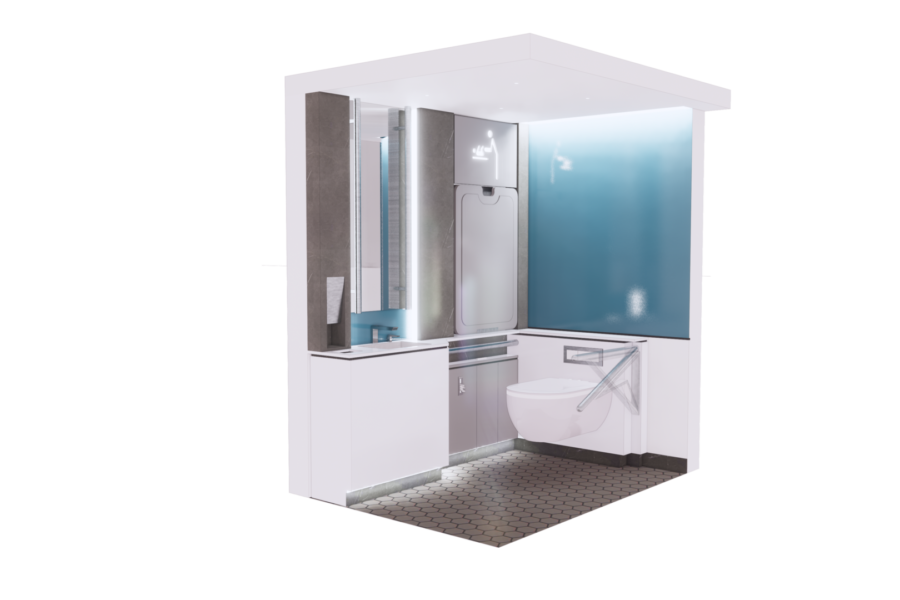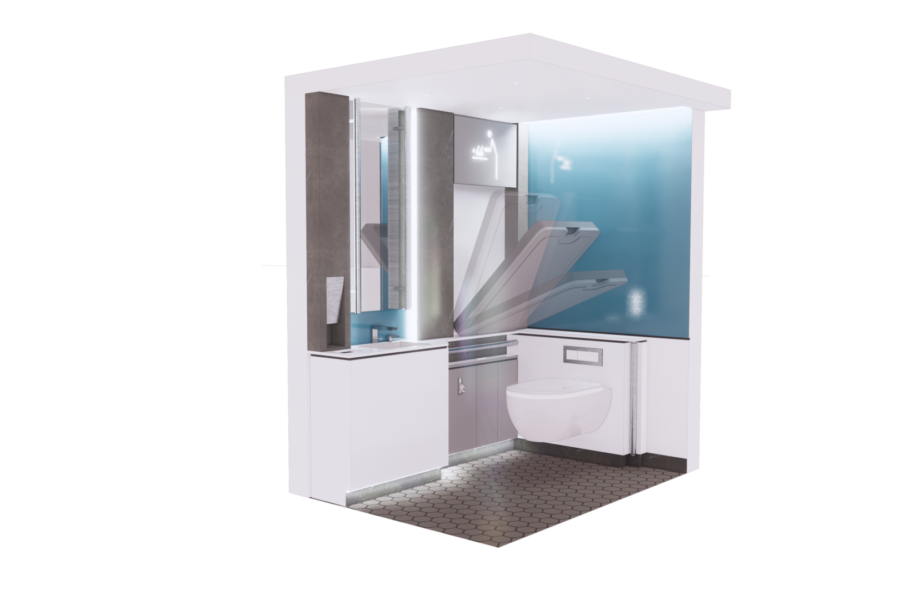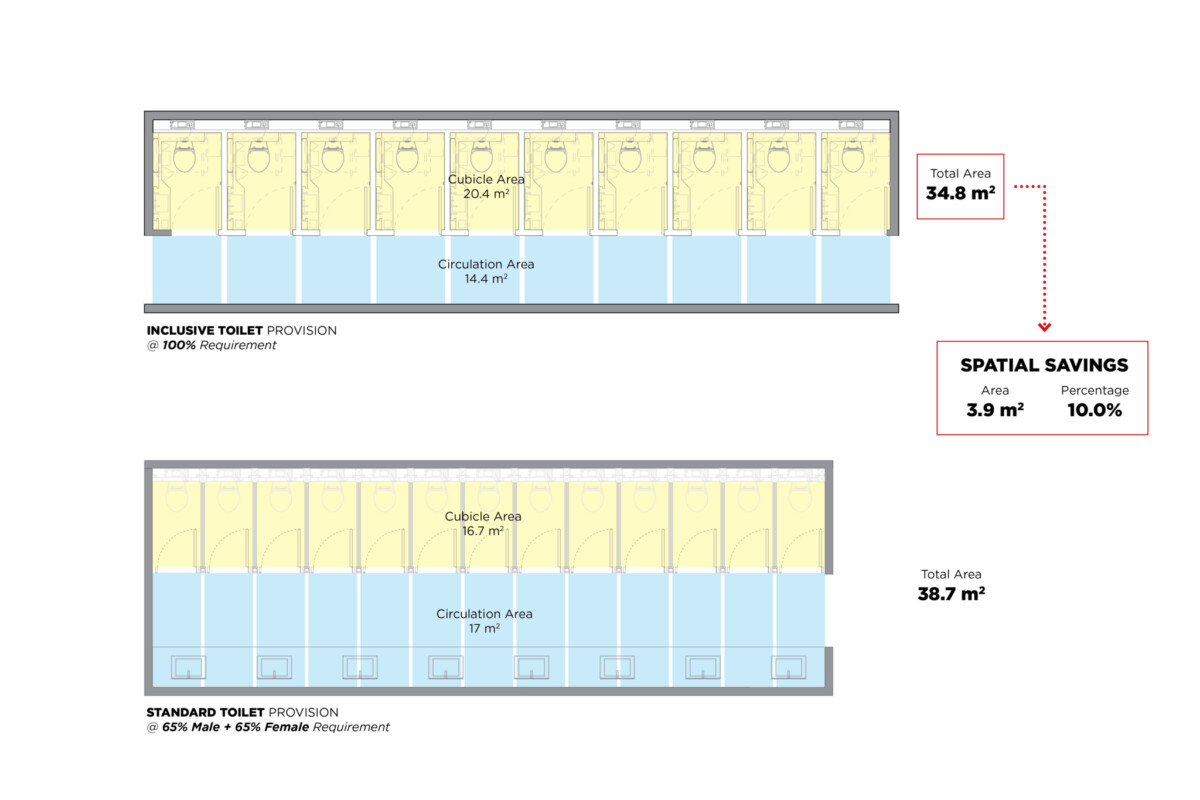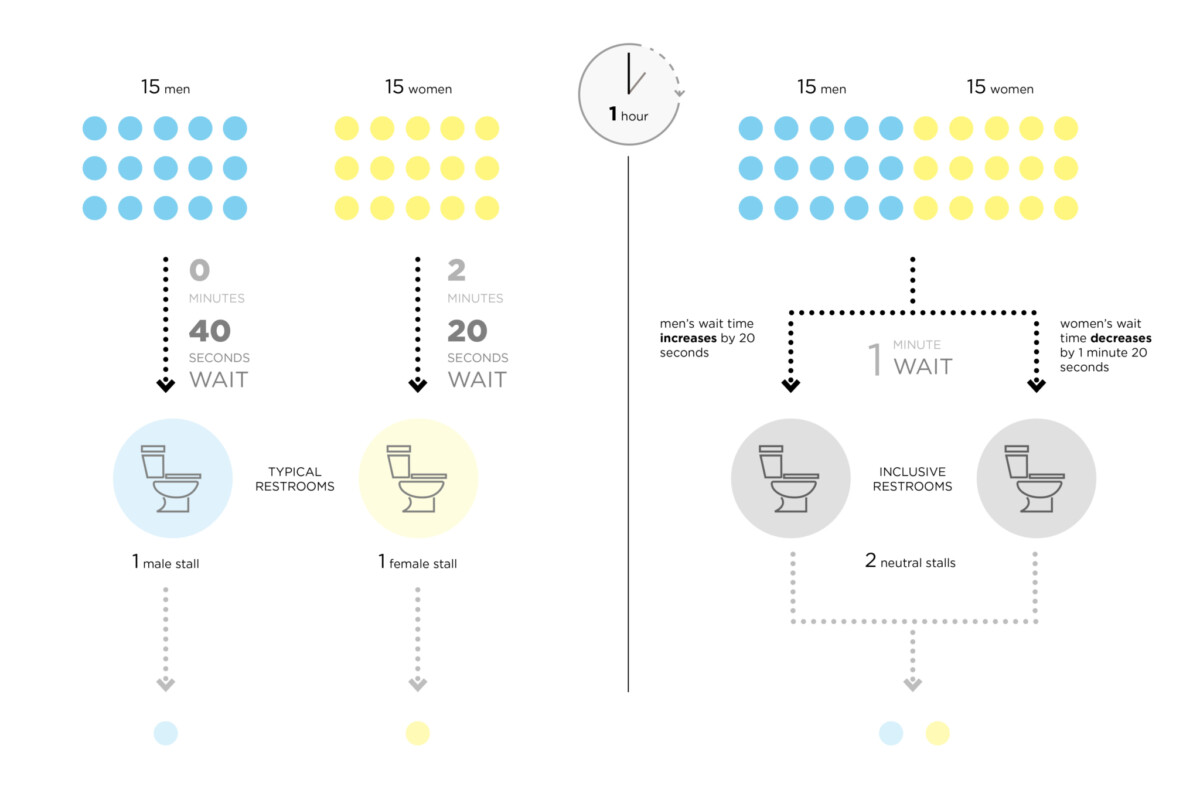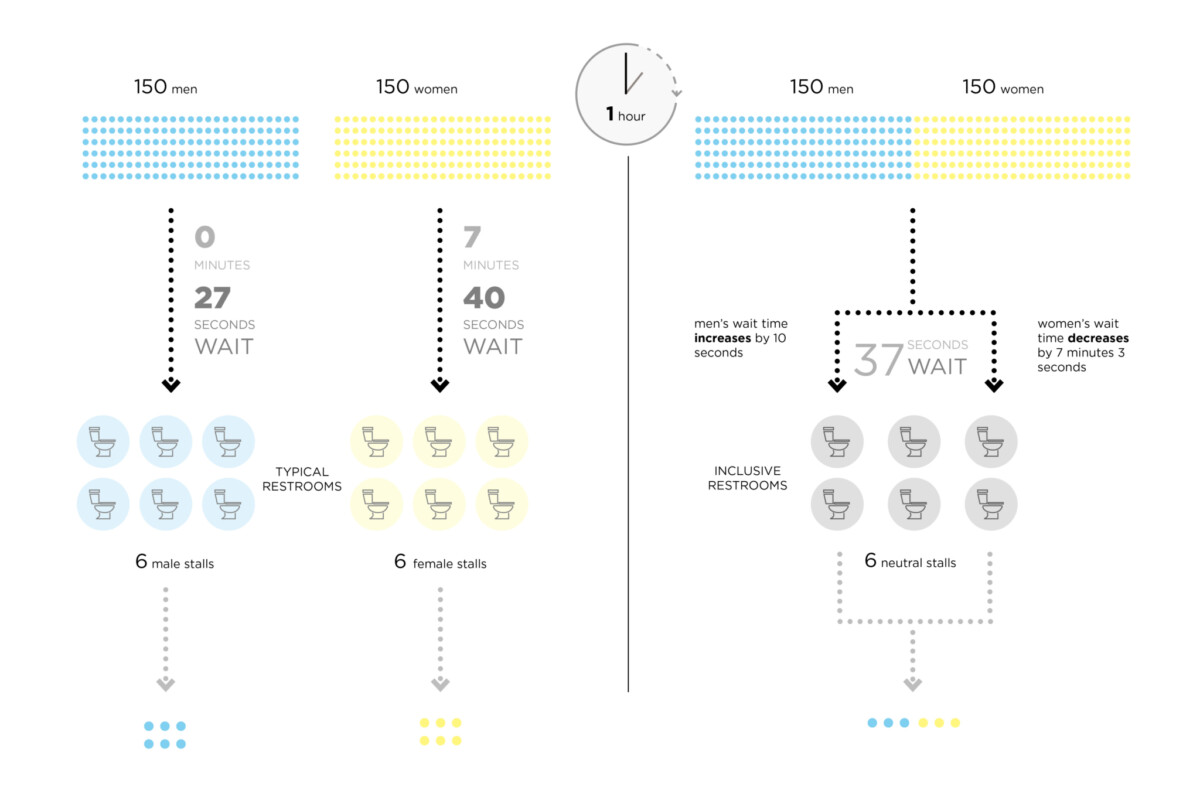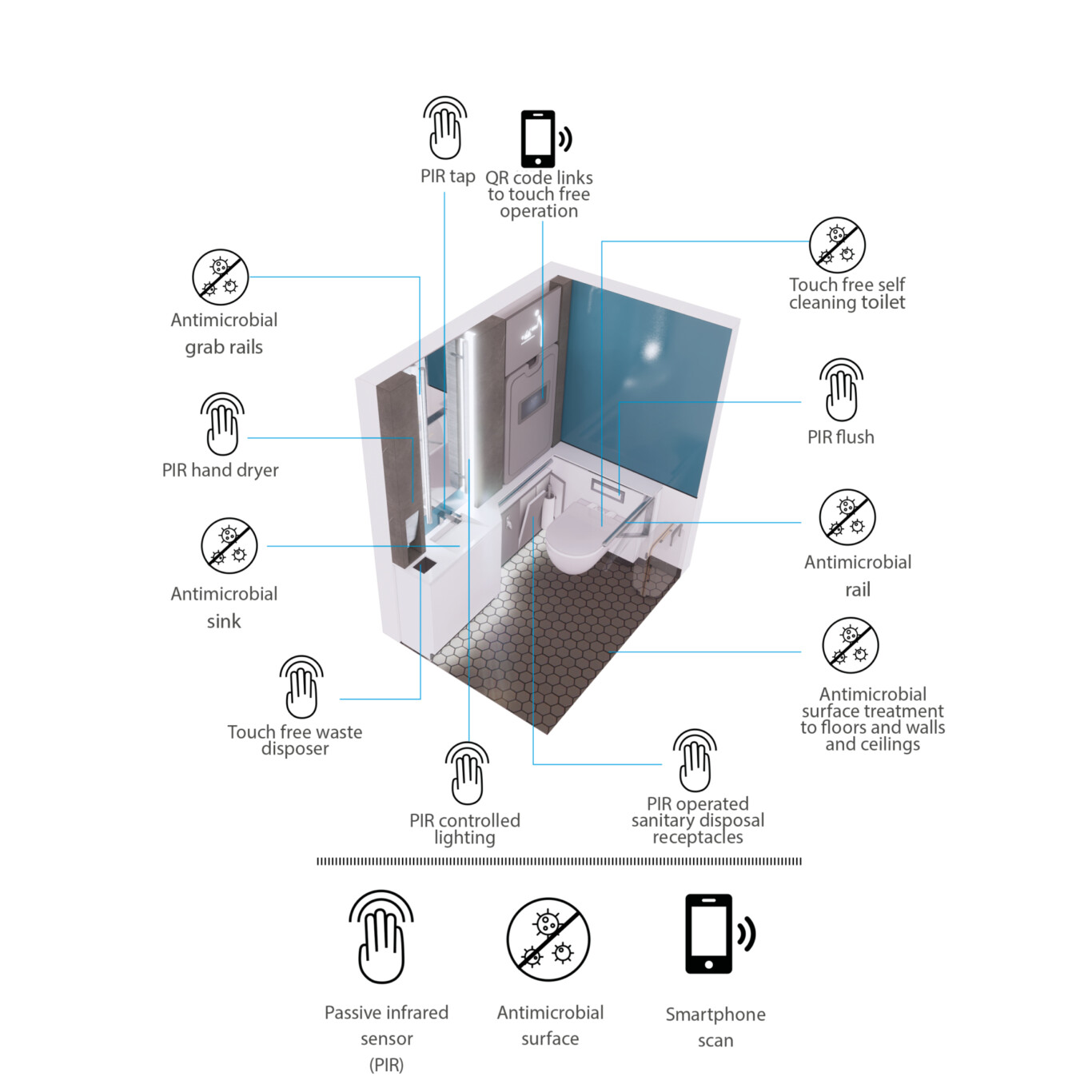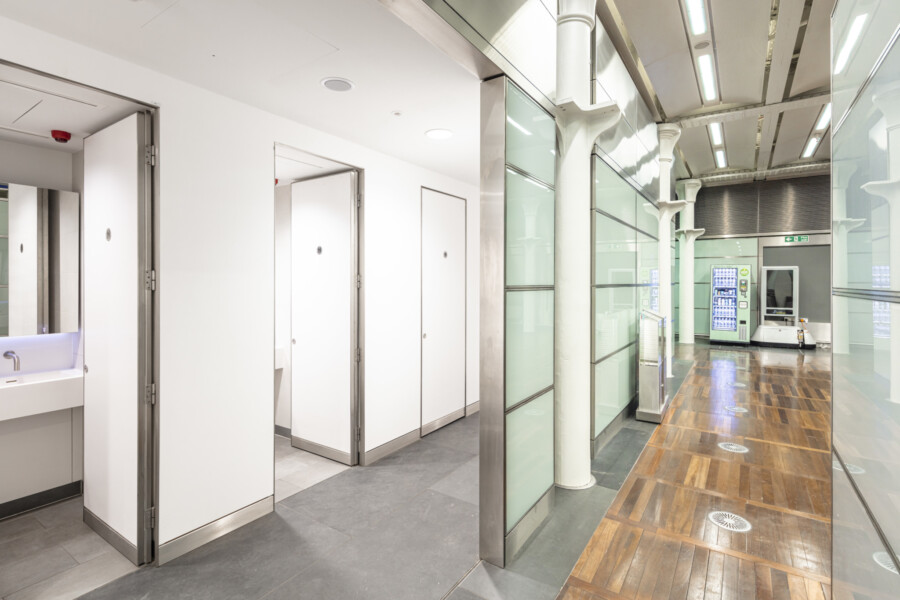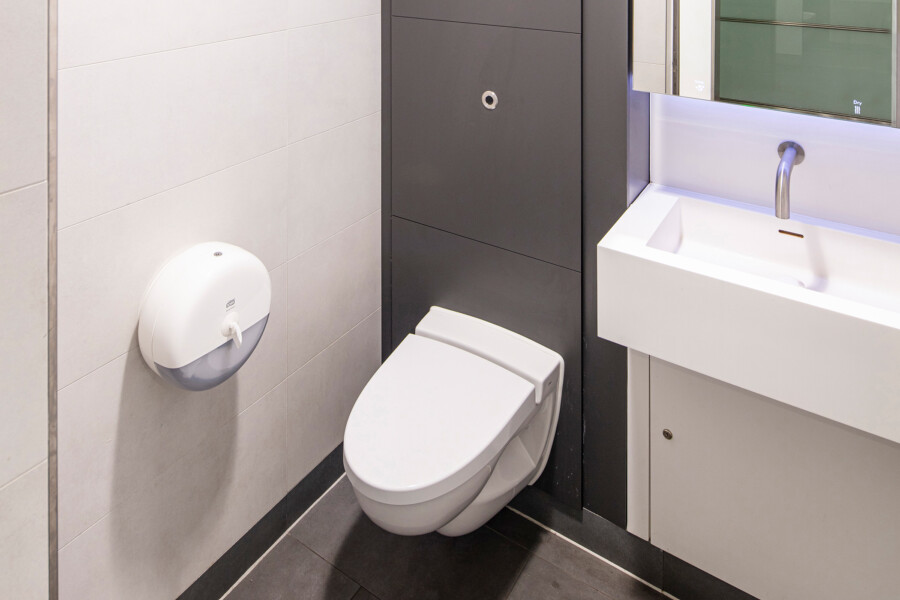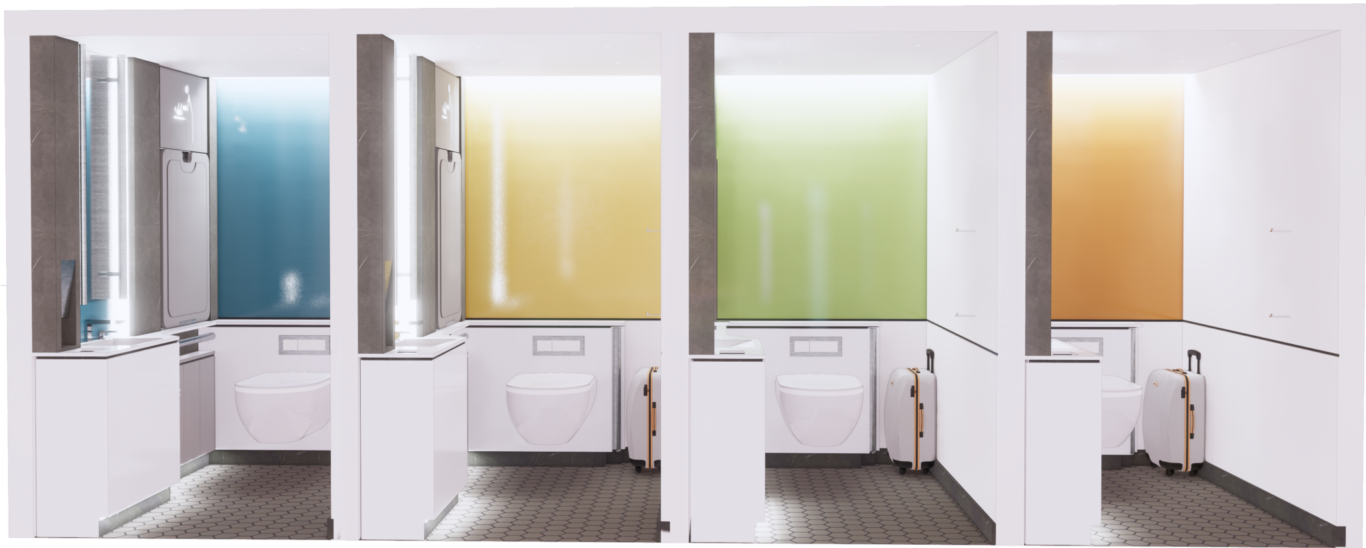
Inclusive Restroom Provision
As part of our continuous improvement and research programme, Chapman Taylor investigated how we could potentially improve and better integrate toilet provision for disabled individuals within transport environments. Our ideas then expanded beyond inclusion for people with disabilities and began to encompass the gender identity, ability and age of users, prompting us to rethink how we design our most familiar spaces so that we can uphold the basic rights of everyone.
In this Insight paper, our Transport Research Group sets out Chapman Taylor’s findings on this issue and how these are now being implemented so that everyone can easily access what are fundamental provisions.
Physical Inclusion
Reconsideration of toilet/welfare facilities within transport environments is necessary because the current general requirements are often insufficient for a significant number of people, including carers and dependants and the increasing number of older passengers using our transport hubs as life expectancy grows. Improved standards of living, nutrition and medical treatment are extending human life expectancy and enhancing quality of life, with the result that an increasing number of older passengers are using our transport hubs.
This ‘grey boom’ presents both challenges and opportunities. As the population ages, there will be improved health and mobility among older people, but there will also be an increase in the need to accommodate impaired ability, whether physical, sensory or cognitive, including increased wheelchair space. Providing better-considered facilities will enable a growing proportion of the population to enjoy the other experiences within our transport facilities – and the operators will benefit in turn.
We have too long viewed how we design such facilities as a matter of meeting statutory requirements rather than on a human-centred level – almost as an afterthought, rather than a matter of fundamental importance to people. This, along with a general unfamiliarity with the needs of a wide range of people, has also led to the use of utilitarian ‘catalogue’ components that may have an ‘institutional’ feel at odds with the aesthetic of the rest of the project. Our study scope was inspired by our desire to better integrate bathroom facilities and to improve general design and specification quality.
Our study began with the contention that providing enhanced facilities for all would also provide inclusivity for those with a wider range of conditions. We wanted to prove that this could be achieved without significant (or possibly any) increases in cost or space-take.
Gender inclusion
Gender-neutral facilities are appearing in many institutions, to mixed reactions. There have inevitably been some strongly adverse reactions, but there is a sense among many that this is a positive move, particularly with the all-in-one facility approach. A further area of debate is how we can identify these facilities for wayfinding purposes without causing offence to anyone, as can be the case with traditional pictograms. We decided that the best approach is to identify the specific facilities on offer, rather than referring to the characteristics of the people using those facilities.
This led us to combine the two strands in an overall inclusivity study. By coincidence, we simultaneously started working on a project at St Pancras International railway station in London, where, due to space constraints driven by the 19th Century Grade 1-listed building’s strict requirements, as well as passenger capacity targets, we proposed independent, fully enclosed, unisex cubicles.
There are different possible formats for gender-neutral facilities – some with shared washing facilities, some with completely separate facilities and some with hybrid configurations. We focused on the separate all-in-one arrangement, because this gives greater potential to accommodate the widest range of abilities, luggage, carers and parent-and-child needs.
Until now, when defining capacity requirements for the traditional, separated arrangement, we have tended to over-provide for both male and female use, by as much as 120 to 130%. By providing gender-neutral, or rather ‘inclusive’, facilities, we can arguably save 20% of provision space and possibly use that to add more room for manoeuvre, for luggage or carer in each separate unit.
Queueing equity
An advantage of the inclusive facilities is that it creates equity in queuing times. Research from Ghent University, looking at queueing times, found shared facilities would cut wait times by 63%.
The research showed that women spend as much as a third longer in toilets compared with men, with significantly longer queues. In general, women deal with more clothing, open and close additional doors, have fewer options and tend to tidy up more diligently. On the flip side, men typically walk up to a fixture, do the basics and then walk away.
Suppose that we have a set-up with one male and one female single-stall facility, and take a one-hour time period. Imagine that there are 15 men and 15 women in the establishment who will hear the call of nature once over this period. On average, men will wait to use the toilet for 40 seconds, and women for 2 minutes and 20 seconds. However, if we make both stalls gender-neutral, the average waiting time for every person (male or female) will go to one minute, which is a 20-second increase for men and a 1-minute 20-second decrease for women.
Suppose instead that we have male and female multi-stall toilets with six stalls each, and have 150 males and 150 females answering the call of nature over a one-hour period. The average waiting time for men will be roughly 27 seconds, and for women roughly 7 minutes and 40 seconds. If we make them gender-neutral, then the average waiting time will go to 36 seconds – a small increase for men but a substantial decrease for women.
A regularly expressed concern is the anecdotally observed disparity between men and women in terms of the level care for the facilities and consideration shown for subsequent users. While this is a real issue for some, it is one that we hope will prove to be less of a problem than anticipated.
Integrated inclusion
Our proposal takes the form of a unit that combines all of the Part M-recommended support infrastructure in an aesthetically integrated way, as well as considering the requirements of passengers of gender fluidity and those with ‘cabin’-sized luggage.
An additional benefit to our inclusive restrooms is the capability to accommodate an additional person of any gender to support the elderly, young or disabled in need of caregiver or parental assistance. The units consist of a single toilet and a sink and will be fitted with a baby change facility marked with an illuminated sign. The hand dryer, soap dispenser and waste receptacles are integrated within the fitting, maximising clear space for carry-on luggage and manoeuvring. Handrail location has been thoroughly considered, with one handrail integrated into the wall and a second deployable one placed adjacent to toilet. All units have full-height enclosures and doors to create visual and acoustic separation.
Special consideration has been given to the visual contrast of materials. The dark-coloured floor provides contrast with the white vertical surfaces and, together with the feature backwall’s vibrant colour, they improve visual acuity and the perception of the room’s boundaries for partially sighted people.
In the choice of materials and fixtures and fittings, we have maximised the use of sustainable components and minimised the total number of components to reduce costs and maximise ease of maintenance. Robust lower wall panels and skirting have been placed to withstand damages from luggage and an acrylic, non-porous countertop has been placed around the sink. High-gloss vertical surfaces will facilitate easy cleaning.
Post-COVID-19 infection control
In the post-pandemic era, infection control will be vital for public restrooms. The components within our design can be easily specified to provide additional security and improve hygiene by minimising exposure to potentially infected surfaces. Many of these are environmentally sustainable standard features, such as passive infrared sensor (PIR) fittings.
Crucial for optimising infection control is consideration of the nature of the materials and surfaces, a reduction of the need to touch fixtures and fittings and the provision of additional cleaning features.
As well as PIR fittings, we have proposed the use of antimicrobial* surface and fixture finishes. There are a number of options available to us for treating a range of surfaces, including composites, ceramics and glass.
We have also considered carefully detailing junctions, corners and rises to minimise the potential for out-of-reach surfaces and the build-up of debris.
We have also suggested the use of PIR-activated features in elements such as sanitary receptacles. An alternative option is the use of smartphones that can be used to operate facilities, such as the change table, touch-free.
Finally, the cubicles’ MEP systems can be upgraded to increase filtration and air changes and can also include built in self-cleaning, such as electrostatic cleaning or photohydroionisation dowsing for regular or emergency anti-pathogenic treatment of spaces.
The implementation of these design innovations to protect people’s health will help to ensure that people have confidence in the cleanliness of public restrooms.
Project SPICE, St Pancras International
Chapman Taylor worked alongside HS1 and Eurostar on a project at the 19th century Grade I-listed St Pancras International railway station in London. The aim of the project was to improve departure capacity for the international rail terminal at the station by creating an additional independent departure lounge with all the required infrastructure, including sanitary facilities, to provide Eurostar’s passengers with a faster security check and a better overall journey experience.
Working within the historic building required a careful and efficient use of space, materials and details in a way which would allow new spatial elements and volumes to blend harmoniously with the heritage fabric. During the design and construction processes, we worked closely with HS1’s historic building advisor to establish the constraints and make sure that proposed changes protected key sightlines and followed the high standards set for this building.
One of the biggest design challenges we faced during this project was the sanitary block layout. We were expected, both from an aesthetic and a space economy point of view, to create the block to be as small and unobtrusive as possible while still facilitating a high-value passenger experience in line with the Eurostar brand. After several layout trials and complex discussions with all of the involved stakeholders, we put forward a proposal based on fully enclosed, independent, unisex cubicles.
The layout consists of base units and units fully adapted to the needs of passengers with greater physical disabilities, with the base units having a uniform configuration of toilet pan and washing unit. That configuration allowed us to use the space in front of the fixtures more efficiently, providing more generous manoeuvre zones and space for luggage. The use of vanity units with integrated soap dispensers and hand dryers, along with illuminated signage, also helped us to maximise the space for manoeuvre within the cubicles.
The materials used in all the units provide high contrasts, which make the units suitable for visually impaired passengers while providing an elegant aesthetic, blending harmoniously with the heritage fabric.
Sanitary facilities are a key touch point and lasting perception for users of public buildings, in particular those which are transport-related. A thorough and thoughtful approach is essential for ensuring that no sacrifices have to be made and that both aesthetic goals and all users’ needs can be met.
Chapman Taylor has implemented several steps towards inclusivity in the renovation of St. Pancras International. We believe that more and more designers will consider and promote inclusive restrooms as an appropriate design solution for both retrofits and new-builds. In addition to the prospective cost, spatial and queue-time savings, we believe that the shift of perceptions about restrooms and the facilitation of unrestricted accessibility is a progressive step towards a more inclusive society.
* An antimicrobial surface contains an antimicrobial agent that inhibits the ability of micro-organisms to grow on the surface of a material. This may involve applying a coating to a surface that has a chemical compound which is toxic to micro-organisms. Photocatalytic materials, as well as the fact that copper and its alloys (brasses, bronzes, cupronickel, copper-nickel-zinc and others) are naturally antimicrobial materials, add further options.
